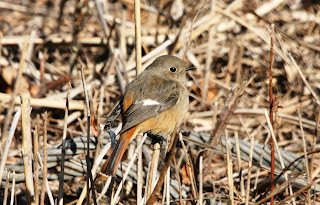 |
| Oriental Stork Ciconia boyciana with Grey Heron Ardea cinerea (note the size difference) |
 |
| Oriental Stork Ciconia boyciana |
 |
| Oriental Stork Ciconia boyciana |
A rare visitor to Jeju, the Oriental Stork is an endangered Eastern Asian endemic. There are no recent breeding records for Korea, and only a few dozen individuals are recorded annually. This individual attracted the attention of the local media. My amazing birding buddy Youngho took me out to see this massive and serene bird one hazy morning, and my pulse was racing the whole time. It dwarfed a nearby Grey Heron, which is usually the largest species around.
Here on Geoje, the ducks of winter remain in solid numbers on the local rivers and harbours, while species like Yellow-throated Bunting, a variety of tits, and Vinous-throated Parrotbills are still plentiful in the hills. Thrush numbers seem low this winter, with only single examples of Dusky, Pale, and Scaly Thrush seen lately. I've spotted an increasing number of Black-headed Gulls amongst the more common larger gulls, with about a dozen seen in the harbour recently.
I just purchased a motorcycle, so the promising and quiet peninsulas on the south side of the island will open up to me very shortly!





















































